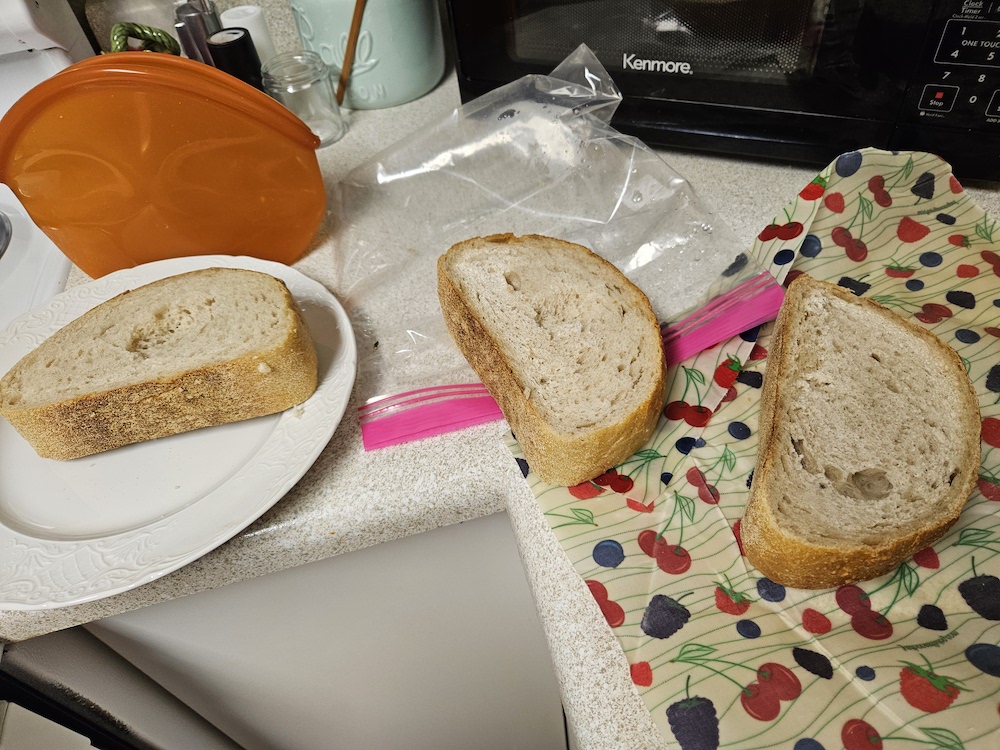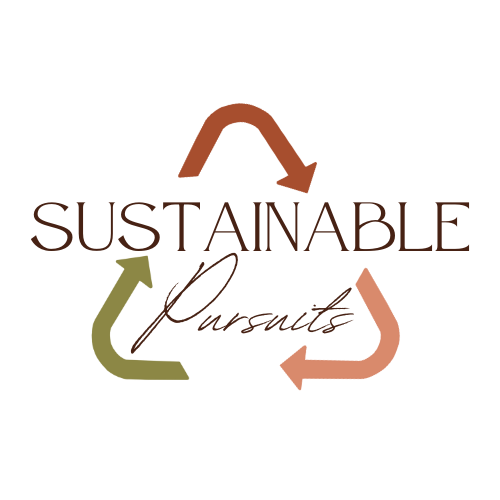We’re coming to the end of this month’s plastic wrap challenge, time to see how well the alternatives compare to plastic. We’ll take a look at how the plastic replacements did with being frozen. I’ll also be sharing some insights about using the silicone products, beeswax wraps, and fabric bowl covers that were featured for this month’s plastic-free challenge.
First, the freezer items. Let’s see how well the silicone, beeswax wraps, and plastic bags (used for comparison) fared. I just examined the remaining batch of bread and crepes that have been in the freezer all month. Here is the chart to describe how they turned out:
| Plastic | Silicone | Beeswax Wrap | |
| Bread | Appearance – has ice crystals and freezer burn Taste – bit dry | Appearance – ice crystals, least amount of freezer burn Taste – Good | Appearance – has most freezer burn Taste – dry |
| Crepes | Appearance – freezer burn Taste – good | Appearance – least amount of freezer burn Taste – Good | Appearance – has most freezer burn Taste – taste and texture is a bit off |
In this case, after 4 weeks of being in the freezer, the silicone did just as good as the plastic if not better. I would like to mention that beeswax wrap is recommended for foods that need breathable storage and not really intended for freezing. This is because beeswax doesn’t form an airtight barrier. I just wanted to see how it would compare to the others.

Which plastic wrap alternatives do I personally prefer?
I really do prefer the silicone and cloth covers over the beeswax wraps. This is due largely to the wax wraps being so fiddly to wash and dry. while the silicone and fabric covers are easy to clean. I always end up getting water every where when I wash the beeswax wraps. But the silicone really is the easiest to clean because it can go in the dishwasher. And the fabric bowl covers can go in the washing machine if needed.
When it comes to the fabric bowl covers, you’d think washing them by hand would have the same problems as the beeswax wraps, but not really. Something about the elastic makes them more manageable to wash and hang dry. The downside of the cloth bowl covers is that you are limited in what you can cover.
The beeswax wraps have the advantage of being able to mold to any shape. Admittedly though, I have a difficult time getting the beeswax wraps to mold into a shape and hold that shape. Whereas the fabric bowl cover usually does a good job staying in place because of the elastic.
Personally, I use the fabric bowl covers the most
When it comes to covering bowls, I really do prefer the fabric bowl covers of the 3 choices. I also like the silicone lid covers but the ones I have (which are a flat disc that covers the bowl or pan) tend to get knocked off their vessel really easily in the fridge. The fabric bowl covers stay in place with no problems. The silicone does have the advantage over the bowl covers in that it can be used to cover hot pots and pans while cooking.
My other article goes into more detail on the best practices for these 3 plastic wrap alternatives.
Silicone works well too
I really do like the silicone pouches as plastic bag replacements. Though, I might feel differently if I didn’t have a dishwashing machine but they aren’t that bad to wash by hand either. I feel more confident using the silicone now that I’ve learned more about them and tested them in the freezer. It’s really handy that the silicone can be used in the oven and microwave as well as the freezer.
I ended up unintentionally testing 2 silicone companies pouches. I’m mentioning this because the 2 companies have different pouch shapes and closures. While both worked well, I personally really liked the FoodHuggers brand best. In my experience, the closure design on their pouches worked better for staying closed. And the FoodHuggers pouch shape is better suited for storing foods with more liquid. On that note, I’m still glad I got the other brand and will continue to use it because their flat pouch shape works well for crepes. All in all, silicone is a good choice as long as it is platinum grade and food-safe certified.
I’ll still keep Beeswax Wraps on hand
I know I’ve been a bit disparaging about the beeswax wraps, but I’m still going to keep them on hand. They are the only plastic wrap alternative that can be used when the others aren’t the right size or shape. When you need some sort of protective sheet to wrap around something, the beeswax wraps are the truest replacement for plastic wrap. Granted, they don’t work too great in the freezer. But based on the results from storing rice balls, they do okay in the fridge.
What I learned from this month’s plastic wrap challenge
To fully replace plastic wrap and bags I will have to utilize all 3 alternatives, plus any others I come across. The biggest challenge for replacing plastic wrap and bags in the freezer is that plastic has a lot more bag size options. But there are still plenty of good options for replacing plastic wrap. In fact, after working with silicone, fabric bowl covers, and beeswax wrap I’ll happily keep using them as my plastic alternatives.
My key takeaways from this month’s plastic wrap alternatives challenge:
- Silicone containers are actually more versatile than plastic due to their temperature resistance.
- Fabric bowl covers are easy to make and there are laminated fabrics (for better protection) available that are plastic-free.
- Beeswax wraps are a bit more difficult to work with but are the go-to for a true plastic wrap replacement when it comes to items that need to be fully wrapped.

